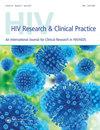Assessment of the HIV Enhanced Access Testing in the Emergency Department (HEATED) program in Nairobi, Kenya: a quasi-experimental prospective study.
IF 1.8
4区 医学
Q3 INFECTIOUS DISEASES
引用次数: 0
Abstract
BACKGROUND Persons seeking emergency injury care are often from higher-risk and underserved key populations (KPs) and priority populations (PPs) for HIV programming. While facility-based HIV Testing Services (HTS) in Kenya are effective, emergency department (ED) delivery is limited, despite the potential to reach underserved persons. METHODS This quasi-experimental prospective study evaluated implementation of the HIV Enhanced Access Testing in Emergency Departments (HEATED) at Kenyatta National Hospital ED in Nairobi, Kenya. The HEATED program was designed as a multi-component intervention employing setting appropriate strategies for HIV care sensitization and integration, task shifting, resource reorganization, linkage advocacy, skills development and education to promote ED-HTS with a focus on higher-risk persons. KPs included sex workers, gay men, men who have sex with men, transgender persons and persons who inject drugs. PPs included young persons (18-24 years), victims of interpersonal violence, persons with hazardous alcohol use and persons never HIV tested. Data were obtained from systems-level records, enrolled injured patient participants and healthcare providers. Systems and patient-level data were collected during a pre-implementation period (6 March - 16 April 2023) and post-implementation (period 1, 1 May - 26 June 2023). Additional, systems-level data were collected during a second post-implementation (period 2, 27 June - 20 August 2023). HTS data were evaluated as facility-based HIV testing (completed in the ED) and distribution of HIV self-tests independently, and aggregated as ED-HTS. Evaluation analyses were completed across reach, effectiveness, adoption, implementation and maintenance framework domains. RESULTS All 151 clinical staff were reached through trainings and sensitizations on the HEATED program. Systems-level ED-HTS among all presenting patients increased from 16.7% pre-implementation to 23.0% post-implementation periods 1 and 2 (RR = 1.31, 95% CI: 1.21-1.43; p < 0.001). Among 605 enrolled patient participants, facilities-based HTS increased from 5.7% pre-implementation to 62.3% post-implementation period 1 (RR = 11.2, 95%CI: 6.9-18.1; p < 0.001). There were 440 (72.7%) patient participants identified as KPs (5.6%) and/or PPs (65.3%). For enrolled KPs/PPs, facilities-based HTS increased from 4.6% pre-implementation to 72.3% post-implementation period 1 (RR = 13.8, 95%CI: 5.5-28.7, p < 0.001). Systems and participant level data demonstrated successful adoption and implementation of the HEATED program. Through 16 wk post-implementation a significant increase in ED-HTS delivery was maintained as compared to pre-implementation. CONCLUSIONS The HEATED program increased overall ED-HTS and augmented delivery to KPs/PPs, suggesting that broader implementation could improve HIV services for underserved persons already in contact with health systems.肯尼亚内罗毕急诊科艾滋病病毒强化检测(HEATED)项目评估:一项准实验性前瞻性研究。
背景寻求紧急伤害护理的人通常来自高风险和服务不足的重点人群(KPs)和艾滋病计划的优先人群(PPs)。尽管肯尼亚基于设施的 HIV 检测服务(HTS)非常有效,但急诊科(ED)提供的服务却很有限,尽管它有可能惠及服务不足的人群。方法这项准实验性前瞻性研究评估了肯尼亚内罗毕肯雅塔国立医院急诊科(ED)实施 HIV 加强急诊科检测(HEATED)的情况。HEATED项目是一项由多部分组成的干预措施,采用了艾滋病护理宣传和整合、任务转移、资源重组、联系宣传、技能开发和教育等适合当地环境的策略,以促进急诊科艾滋病检测,重点关注高危人群。高危人群包括性工作者、男同性恋者、男男性行为者、变性人和注射毒品者。感染者包括年轻人(18-24 岁)、人际暴力受害者、酗酒者和从未接受过艾滋病毒检测者。数据来自系统级记录、登记的受伤患者参与者和医疗服务提供者。在实施前(2023 年 3 月 6 日至 4 月 16 日)和实施后(第一阶段,2023 年 5 月 1 日至 6 月 26 日)收集了系统和患者层面的数据。在实施后的第二阶段(阶段 2,2023 年 6 月 27 日至 8 月 20 日)收集了更多系统级数据。半边天数据作为独立的设施艾滋病毒检测(在急诊室完成)和艾滋病毒自我检测分发进行评估,并作为急诊室半边天数据进行汇总。结果通过 HEATED 项目的培训和宣传,所有 151 名临床工作人员都接受了培训。在所有就诊患者中,系统级 ED-HTS 从实施前的 16.7% 增加到实施后第一和第二阶段的 23.0%(RR = 1.31,95% CI:1.21-1.43;p < 0.001)。在 605 名登记的患者参与者中,基于设施的半边天从实施前的 5.7% 增加到实施后第 1 期的 62.3%(RR = 11.2,95%CI:6.9-18.1;p <0.001)。有 440 名(72.7%)患者参与者被确认为 KPs(5.6%)和/或 PPs(65.3%)。对于注册的 KPs/PPs,基于设施的半边天计划从实施前的 4.6% 增加到实施后第一阶段的 72.3%(RR = 13.8,95%CI:5.5-28.7,p < 0.001)。系统和参与者层面的数据表明,HEATED 计划的采用和实施取得了成功。结论HEATED项目提高了ED-HTS的总体水平,并增加了向KPs/PPs提供的服务,这表明更广泛地实施该项目可以改善已与医疗系统接触的服务不足人群的艾滋病服务。
本文章由计算机程序翻译,如有差异,请以英文原文为准。
求助全文
约1分钟内获得全文
求助全文

 求助内容:
求助内容: 应助结果提醒方式:
应助结果提醒方式:


